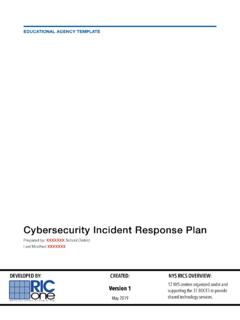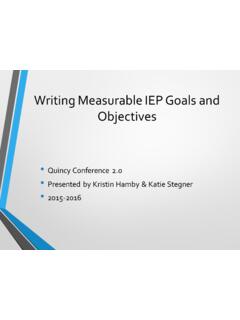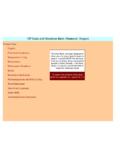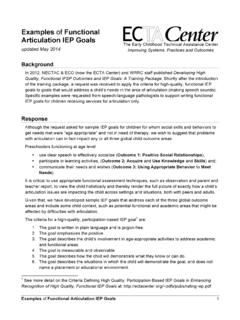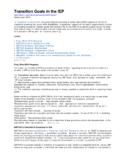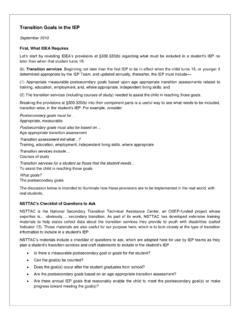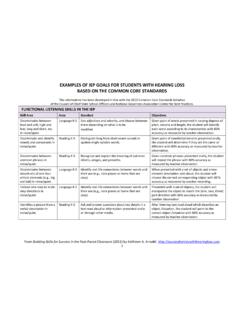Transcription of Developing Measurable IEP Goals - esboces.org
1 Developing Measurable IEP Goals 1. Consider the Do Now Activity following statement: Goals are not written, they are developed.. 2. Introductions Arlene B. Crandall Regional Special Education Training Specialist RSE-TASC. Attendee introductions 3. Agenda & Materials Power Point Handout Tools Activities 4. Training Goals Understand the relationship between: Present Levels of Performance &. Measurable Annual Goals Develop Measurable IEP Goals 11) Placement 10) Special Transportation Development 9) Participation in State Assessments, and & with Students without Disabilities 8) Coordinated Set of Transition Activities Sections of 7) Testing Accommodations the IEP. 6) 12 month Services (if needed). 5) Programs and Services Modifications &. Supports 4) Reporting progress to parents 3) Annual Goals , Objectives / Benchmarks (if needed).
2 2) Measurable Post Secondary Goals and Transition Needs 1) Present Level Of Performance 6. PLPs are the Foundation of the IEP. 7. Key words or phrases The PLP provides the informational basis (what the student does now) for generating Goals , supports and services that are specifically designed to meet the student's individual needs and begin to prepare them to select and reach their post-secondary Goals . 8. Present Levels of Performance Goal PLP. You cannot know how far you have come if you don't know where you started. 9. PLP Information Comes From: 10. Create a clear picture of the student. If the student moved to Montana tomorrow, could the new teacher read the PLP. and know his/her instructional strengths & needs? 11. Why Develop Goals ? 12. Why Develop Goals ?
3 Align student's program with learning standards guide monitoring of progress toward meeting the standards assess appropriateness of services in supporting the student in meeting Goals provide meaningful reports to parents about actual growth 13. Goals Provide an Instructional Roadmap Would you tell me please, which way I. ought to go from here? . That depends on where you want to get to.. Lewis Carroll, Alice in Wonderland 14. An Annual Goal is . a statement that identifies what knowledge, skills and/or behaviors a student is expected to be able to demonstrate within the year during which the IEP. will be in effect.. IEP Guide, page 30 15. Annual Goals Individualized Prioritized Reasonable 16. Key Questions for Prioritizing Goals : What is preventing this student from participating in a less restrictive environment and/or from progressing in the general education curriculum?
4 What foundation skill needs cross multiple content areas and settings? ( reading). How many Goals are reasonable given the student's abilities and rate of progress? 17. Accessing the General Education Curriculum Develop Goals that answer the question: What skills does the student require to master the content of the curriculum? . NOT. What curriculum content does the student need to master? 18. OG. Backward Design Goal: What skill/behavior do you want to see change? Schedule: How frequently should I evaluate performance and make adjustments? Method: How will the performance be recorded? Who will record the performance? Criteria Period: How long will it take to demonstrate proficiency? Criteria: What is my standard for performance? 20. What makes Goals Measurable ?
5 21. Observable? . Or Not? Point to Understand Circle Know Spell orally Grasp the meaning of List in writing Remember Read orally Identify Walk Enjoy Count Be familiar with State Participate in What does it look like? Will you know it when you see it? 22. Sample Goal Template Annual Goal Criteria Method Schedule (The Task) (The Final Exam) (The Tool) (How often do I check in?). Given what Tangible How often method to you Student will evaluate evaluate do what to what How well extent/ AND. Over what period of time Student does this Adult does this 23. How well must the Criteria student perform and over what period of time? -accuracy -duration -frequency -speed -distance -# of trials -time frame 24. Criteria Goals may need more than one criterion 50 words /min.
6 With 3 or fewer errors (to what extent & how well). 85% accuracy over 5. consecutive trials (criteria & criteria period). 25. Criteria: measurement data collection strategies (Kosnitsky, 2008). 1. Duration how long a behavior lasts (amount of time on task). 2. Frequency how often a behavior occurs (number of times student raises hand and waits to be called on). 3. Latency length of time between stimuli and response (time it takes for student to begin work after teacher gives directions). 4. Interval percentage of time a behavior occurs (percentage of time a student is rocking). 26. Criteria: Some Guidelines Start with the baseline data in the PLP. Be realistic, but aim high Ask yourself: To what degree and for what length of time does the student have to demonstrate this skill/behavior to show he/ she has achieved the goal?
7 27. The Legend of 80%. Tommy will successfully cross the street at the crosswalk, without staff assistance 80% of the time.. 28. Method for Evaluation How will you measure progress? Scoring of work sample using a rubric Curriculum-Based Measurement probe Observation with behavior checklist/rubric Review of statistics NOT: Teacher Observation or Teacher Assessment;. what is seen is recorded in objective, non- judgmental statements 29. Plan to 1. What kind of Measure data will be Progress collected? 2. Who will collect data? 3. Where will data be collected? 30. Schedule for Evaluation How often do you review collected data? Examples: Daily Weekly Monthly Fourth week of each quarter Every 5 weeks On January 5, March 15, and June 3 31. The Schedule is NOT: When you will report progress to the parent (this goes in a separate section of the IEP).
8 By June (Too late to re-evaluate). Is this strategy working or not? Data helps you make an informed instructional decision 32. Example from case law . Chris will improve his behavior from non-appropriate to appropriate through teacher intervention and small group instruction by June.. Can this goal be changed to make it Measurable ?33. Examples Not Measurable Measurable Emily will improve reading/ Given 10 CVC words Emily will read decoding skills Eight words with no more than three errors Michael will improve his Michael will remain seated for 15. attention minutes during circle time Michele will improve her Given lined paper Michele will copy writing skills all 26 upper-case letters writing on the line 34. Narrative Goal Template Given (conditions, accommodations)*, student name will (do what), (to what extent) & (over what period of time).
9 Or (by when) as evaluated by _____. *This portion is not always required Example: Given a 4-function calculator, Sue will solve ten one-step word problems using addition and subtraction with 90% accuracy on three consecutive weekly trials as evaluated by scoring of teacher made assessments every two weeks. 35. Use data for Developing Goals PLP Present level data PLP needs Annual Goals 85 wpm @ GE develop decoding (Given specially designed what he can do strategies instruction). 40 wpm @ practice fluent reading to The student will achieve . uses initial and final letter build sight vocabulary cues employ self-correction The Annual Goal doesn't use medial sounds strategies esp .when doesn't self correct miscues interrupt meaning Random errors abandons attempts to self What specially designed correct instruction is implied by these needs?
10 How many errors? What kinds of errors? 36. Annual Goal Template Annual Goal Criteria Method Schedule Given 3rd grade with 50% 1 minute bi-weekly passage, self- oral Damien will correction, reading read orally at 90 in 3 probe wpm consecutive with trials charting of wpm, running record 37. Developing Goals for Damien 1. On the Damien 3. Record this information on example, highlight a your template. needs/skill deficit 4. Generate a list of 2. Find evaluative data questions that will need to from the PLP that be answered to document relates to the area needs in Measurable terms of need and highlight it to match 5. Write a Measurable goal to the need address that need. 38. Example Using Sample Goal Template Annual Goal Criteria Method Schedule Given a four As evaluated Every function by scoring of two calculator with 90% teacher- weeks Sue will solve 10 accuracy made one-step word AND assessments problems using on three addition and consecutive subtraction weekly trials 39.
